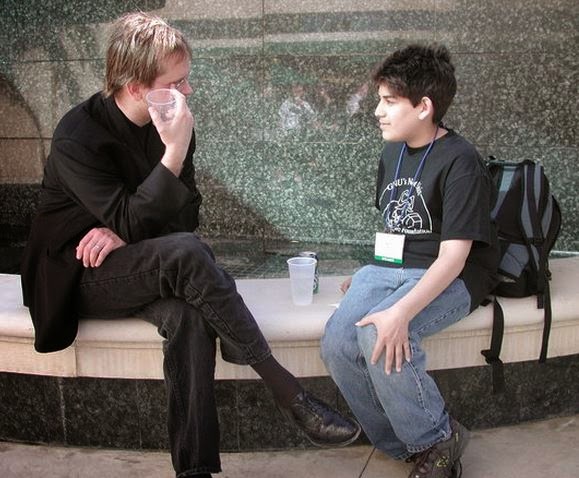Simplified Model
Wallet-sized abstraction to access people and situations psychologically on the fly
My
empathy model is a clean-room abstraction that specifically looks mutually-beneficial interrelations for organismic success, and is easily accepted by the vast majority of people, that is to say, those who normally interrelate. It is fundamentally based on
Dariwn's second important writing that attributes human morailty to the evolution of the "natural affection" of higher animals. It is designed almost as a manual to apply empathy ideas to situations where normal interrelation is problematic or impossible--perhaps to design an avoidance strategy, or, possibly, to fight back as in activism. It strongly suggests that the root problems attacking otherwise normal, happy society are rooted in "anti-complex" organic dysfunction.
With the start of my psych masters, the established empirical model that leverages the ancient Socratic method, the dialectic, introduced to me an entirely new language to describe mental problems that is not accessible to, or easily-used by, the average, normal people. Further, the use of common psychological words from the dictionary such as psychotic and schizophrenic may be considered "unethical" to use with "proper training" (ie, a PhD and a license).
However, there are big changes happening in the study of the mind with the introduction of digital imaging. This change is very popular; more accurate fMRI-evidenced material is being produced now than empirically-evidenced material using the thesis, antithesis, synthesis of empirical science.
Now, mental brain activity as it surfaces as human activity can be seen accurately in images. Maladaptive activity can be directly related to parts of the brain that are failing. That is to say activity (or behavior) that results from an inability to adapt to an internal problem, such as those that are organically-caused by DNA failures, or traumatic resulting from unfortunate events often deliberately caused by others, can be viewed, or seen to be absent, in images on a screen. An important example
is in this article about signalling errors (in this blog) caused by DNA problems where the protein that is supposed to instruct neural function is broken and thus cannot do its job. In this study, patients with the broken signalling process suffer from schizophrenia, psychosis, and bipolar disorder.
This study points us in the right direction. It encourages us to create hypotheses that can suggest that specific major mental illnesses can be caused by specific signalling errors, and that maladaptive activity can be predicted by testing for these errors.
Initially a problem surfaced with an early attempt. If you attempt to tease apart illnesses based signalling errors, this does not help as it accounts for three separate diseases. Psychologists who have been consulted are adamant that schizophrenia and psychosis are completely different illnesses especially in the empathy context--schizophrenics are easy to get along with. When looked at closely, psychosis seems to result in problems in networks (including psychotic depression) that causes "out of control" behavior, and schizophrenia comes from false information signalling in the analytic, executive function, working memory part of the mind, the pre-frontal cortex. It should be noted that the protein signalling errors were correlated with diagnoses made using the DSM, which predates fMRI evidence; the DSM may be (or probably is) dragging fMRI research backwards. Further, one of the very first discoveries while building the empathy model, is that most of those interviewed in the empathy working group who had had problems, had had on average no less that five separate diagnoses; diagnostics are problematic--probably because the DSM is so horribly convoluted.
One component of the cited signalling study could easily be correlated with observed reality. Family members carrying the same hereditary-and-genetic defect had similar fMRI scans as positively-diagnosed participants, but abnormalities were to lesser-degrees. One of my early observed subjects was done in a family setting with me absorbing far more data than I cared for. Family members were higher-functioning but less moral; as described in the empathy model, they applied their dysfunctions as controlling strategies for secondary gain: greed. This goes to the obsessive-compulsive-impulsive continuum that historically links to addictive behaviors that disregard effects on others--money and possessions being two of them along with substances. This puts uncontrolled impulse in the psychotic category.
Modeling
So, to create a workable model that is in line with the empathy model, psychosis (being "out of control") and schizophrenia (hallucinations) are pulled apart and the third important "empathy model" problem, aspergers, is added as it is generally linked with the inability to feel others' emotions, and thus act with respect to them--morally. Since the empathy model is made for the common person (that is to say it is democratic), and since there may be peril in using these terms (because of ethical perversions), the definitions, or descriptions, for the diseases are used rather than the disease names themselves. This is a wallet card that should provide one with a map to avoid the maladaptive behaviors of those whose maladaptions to sickness make them immoral, and thus dangerous. If it is a successful model, it should save the average person a great deal of grief. The purpose of a model is almost the direct opposite of the purpose of an empirical study; a model (such as a business model, or the highly-successful weather models) is to predict phenomena and provide benefits. This model has been doing both for a year, and is thus tested--just not correlated to genetic-fMRI-assessment sicence (yet).
Metacognition
The final item, that is not directly related to signalling errors, is the idea of metacognition that appears in the empathy model as "painting a pretty picture" of poor events to make them more palatable. This is often the basis of cognitive therapy which suggests looking finding an "alternative" way to look at things to relieve troubling symptomatic such as anxiety or depression. The problem is, of course, that the underlying problem is ignored and that only symptoms are addressed. A person could spend their entire life feeling better about a person with dangerous signalling errors, say, to save a marriage, without realizing that their life has been stolen.
In this model's view, the adaption of humanity to signalling errors as they manifest as psychosis, aspergers, and the combination of the two, socio-psychopathy, is at the crux of humanity's failure; it is an alternative to what is natural in that it empowers dangerous people in the traditional sense, it gives them control. In the empathy model sense, the maladaptive are given power to take resources from others through coercion. This is necessary for the emphatically maladaptive because they cannot use empathic abilities and facilities to work with others to create resources.
In this view, psychology (historically with the dialectic and currently with the DSM) have provided an alternative to what is natural using what is called the Socratic method. We normal humans are expected to view maladaption from an alternative perspective, that is to paint a pretty picture in place of reality to make life less anxious and depressing. This, in this view, is the "method" of civilization, the dialectic, and deception.
Normal human success depends on shining a light on it, which is the purpose of this
"simplified model wallet card."
Mediated Citations:
this section is an implementation of annotated bibliography that (eventually) hopes to blend referential support, footnotes, and (most important) forum discussion with the idea that it is our differing influences that define our points of view, and that by combining these influences we should come to agreed-upon explanations for phenomena
Protein signalling from McIntosh, 2009
A look back on this research shows how abstracted this simplified model is, and the size of the gap between pure science and everyday reality. Initially I intended to directly apply the research which links many diseases to a single signalling error, but resistance from experts in the field forced me to reduce this one error to a single disorder, psychosis, because (as they say) psychosis is functionally related to bipolar, but not to schizophrenia. In defense of the pure scientists, the signalling goes to "maintenance" cells such as the astrocyte in the background. (I think of these cells as relatives of neurons).
A though that occurred to me as I first read the studies, is that I had once hypothesized that the fat on the cells, mylein, gets burned off when the mind is over active, such as in the term "burned out." This occurred to me in the mid-90s when I was fixing an expensive desktop computer and noticed that the CPU chip got much hotter when it was running a "batch job" than when it was still. Given the many abstracted similarities between computers and humans, I also assumed human intellectual matter will get hotter in similar proportions, and hence "burn off" the insulation causing dysfunction--in any part of the brain. This implicates both dopamine-exciting meth, and extreme overactivity caused by, say, terror-level fear resulting in trauma, sometimes called an insult.
APA-style citations:
Chong, V., Thompson, M., Beltaifa, S., Webster, M., Law A., and Weickertad, S. (2007). Elevated Neuregulin-1 and ErbB4 protein in the prefrontal cortex of schizophrenic patients: Schizophr Res. 2008 March ; 100(1-3): 270–280. doi:10.1016/j.schres.2007.12.474.
Fazzari, P., Paternain, A., Valiente, M., Pla, R., Luján, R., Lloyd, K., et al. (2010). Control of cortical GABA circuitry development by Nrg1 and ErbB4 signalling. Nature, 464(7293), 1376-1380. doi:10.1038/nature08928.
Homayoun, H., & Moghaddam, B. (2008). Orbitofrontal cortex neurons as a common target for classic and glutamatergic antipsychotic drugs. Proceedings of the National Academy of Sciences of the United States of America, 105(46), 18041-18046. doi:10.1073/pnas0806669105.
Li, B., Woo, R., Mei L., Malinow, R., (2007, May 24). The neuregulin-1 receptor ErbB4 controls glutamatergic synapse maturation and plasticity. Neuron, 54(4), 583-597.
McIntosh, A., Hall, J., Lymer, G., Sussmann, J., and Lawrie, S. (2009). Genetic risk for white matter abnormalities in bipolar disorder. International Review of Psychiatry, 21(4), 387-393. doi:10.1080/09540260902962180.
McIntosh, A., Hall, J., Lymer, G., Sussmann, J., and Lawrie, S. (2009). Genetic loading for psychosis and the internal capsule disorder. International Review of Psychiatry, 21(4), 387-393.
Stone, J., Morrison, P., and Pilowski, L. (2007, January 26). Review: Glutamate and dopamine dysregulation in schizophrenia — a synthesis and selective review. Journal of Psychopharmacology. 21(4), 440-452






